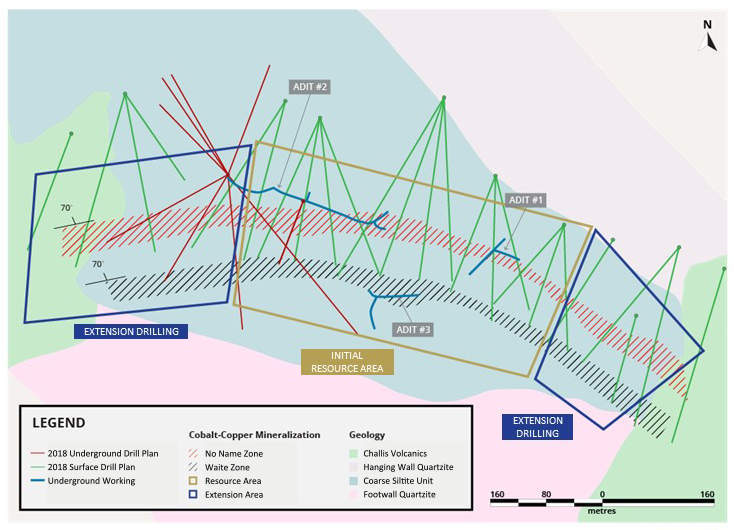First Cobalt has announced acquisition of 100% ownership and elimination of the outstanding royalty on the Iron Creek property in Idaho, US.

Image: The Iron Creek bedrock geology. Photo: courtesy of First Cobalt Corp.
Trent Mell, President & Chief Executive Officer, commented:
“Our outlook for the Iron Creek Project was instrumental in the decision to eliminate the outstanding royalty and acquire 100% ownership of the project at this time. Drilling has identified two broad zones of cobalt-copper mineralization that extend well beyond the historic resource area. The Company is fully funded to complete our work programs in the USA and Canada this year and into 2019. We anticipate releasing preliminary metallurgical work and the maiden resource estimate for Iron Creek in the next few weeks.”
The Iron Creek Project was previously under lease to First Cobalt. Under the terms of the lease, First Cobalt was required to make monthly payments and the leaseholder retained a 4% royalty over future production, both of which could be eliminated through a one-time payment. First Cobalt and the leaseholder agreed to a 47% reduction of this payment to US$1.07 million, which has now been paid in full. As of June 30, 2018, First Cobalt reported a cash balance of $20 million and an additional $2 million in current assets. The Company is fully financed to complete all current work programs including over 30,000m of diamond drilling to further test the cobalt-copper mineralized zones.
Full ownership of the Iron Creek property and elimination of any future royalty payments streamlines future permitting and development activities and accelerates the mine planning process. The Company has begun a consultation process and collecting baseline data for future permitting requirements.
First Cobalt’s Iron Creek property consists of mining patents and exploration claims with significant infrastructure including 600 metres of drifting from three adits and an all-weather road connecting the project to a state highway. Several inferred resource calculations were made in the 1980s and 1990s considering only the No Name Zone, where historic drilling was most dense.
One historic estimate (non-compliant with NI 43-101) by Noranda Inc. reported 1.3 million tons grading 0.59% cobalt and 0.3% copper, using a cutoff grade of 1% copper equivalent. A new NI 43-101-compliant mineral resource estimate calculation is imminent. The Company expects the new resource estimate to realize wider true thickness of mineralization encountered by First Cobalt drilling than previously recognized by the historic calculation. The new resource estimate is expected to include additional lower grade material than the higher grade single zone of mineralization historically recognized. The initial resource estimate will include two zones of mineralization drilled in 2017 and early 2018: the No Name Zone and the Waite Zone (Figure 1).
In June, First Cobalt announced a $9M program intended to accelerate work programs at Iron Creek. Preliminary metallurgical work and the maiden resource estimate are nearing completion and are anticipated in the next few weeks. Throughout July and August, the Company operated three surface drills at Iron Creek (see July 12, 2018 press release) in order to extend the known mineralization along strike and bring a portion of the initial Inferred Mineral Resource estimate into a Measured and Indicated Resource category. This second resource estimate is expected in early 2019 (see June 11, 2018 press release).
The No Name and Waite Zones are roughly parallel and dip roughly 75° to the north, remaining open along strike to the east and west, as well as down dip. To date, the Company has drilled over 520m of mineralization strike length and 250m of dip extension. The No Name Zone and the Waite Zone have true widths between 10m and 30m. Mineralization also occurs between the two zones as 1 to 5m pods. Additional mineralization has been encountered in the hangingwall and footwall of the zones and some holes in the 2018 program are intended to confirm the potential for additional mineralized zones.
Unlike much of the Idaho Cobalt Belt, the Iron Creek Project cobalt mineralization is associated with pyrite rather than minerals containing arsenic. Cobalt-copper mineralization occurs as semi-massive and disseminated pyrite and chalcopyrite along stratabound bands within finely layered meta-sedimentary rocks consisting of interbedded argillite and quartzite. Thin veins of chalcopyrite also cut the bands and meta-sedimentary rocks. Quartzite units make up the hangingwall and footwall to the mineralized meta-sedimentary horizon. This stratigraphic sequence has been mapped at surface and by drilling to extend along strike for at least two kilometres.
Source: Company Press Release
